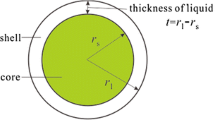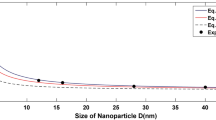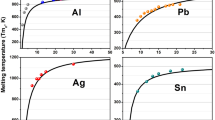Abstract
Nanoparticle research is an exciting field. Serving as a link between bulk materials and atoms, these materials, existing on a nanometre scale (10−9m), display some fascinating properties. One such property is the depression of melting point. As the particle size decreases, the melting temperature decreases dramatically. This article describes a model explaining the origin of this behaviour of nanomaterials (Figure 1). To reinforce the concept in the text and force the reader to think carefully about the quantitative aspects, short problems have been included in the end.
Similar content being viewed by others
References
K K Nanda, S N Sahu and S N Behera, Liquid-drop model for the size-dependent melting of low-dimensional systems, Physical Review A, 66, p.013208, 2002.
F J Heiligtag, M Niederberger, The fascinating world of nanoparticle research, Materials Today, Vol.16, No.7/8, pp.262–271, 2013.
R R Roy and B P Nigam, Nuclear Physics: Theory and Experiment, John Wiley & Sons, Inc, pp.141–154, 1967.
R D Evans, The Atomic Nucleus, McGraw Hill, 1955.
https://nptel.ac.ni/courses/115102017/7
http://hyperphysics.phy-astr.gsu.edu/hbase/Nuclear/shellpau.html#c1 Last accessed on: 21/12/2018
https://en.wikipedia.org/wiki/Semi-empirical mass-formula
J Tateno, An empirical relation on the melting temperature of some ionic crystals, Solid State Commun., Vol.10, No.1, pp.61–62, 1972.
E Roduner, Size matters: Why nanomaterials are different, Chem. Soc. Rev., No.35, pp.583–592, 2006.
K K Nanda, Size-dependent melting of small particles: A classical approach, Eur. J. Phys., Vol.19, No.5, pp.471–472, 1998.
G Schmid, B Corain, Nanoparticulated gold: Syntheses, structures, electronics, and reactivities, Eur. J. Inorg. Chem., Vol.17, pp.3081–3098, 2003.
M Takagi, Electron diffraction study of liquid-solid transition of thin metal films, Journal of the Physical Society of Japan, Vol.9, pp.359–363, 1954.
Acknowledgments
I am much indebted to the anonymous reviewer for patiently and carefully reading through the multiple versions of this manuscript and pointing out the shortcomings. I am sincerely grateful to this reviewer for his/her valuable suggestions which resulted in a significant improvement of the original manuscript.
I acknowledge the scholarship through DST-KVPY. Suggested Reading
Author information
Authors and Affiliations
Corresponding author
Additional information
Abhinaba Das is a KVPY scholar currently studying at the Indian Institute of Science, Bengaluru.
Rights and permissions
About this article
Cite this article
Das, A. Liquid Drop Model Explaining Melting Point Depression of Nanoparticles. Reson 25, 215–231 (2020). https://doi.org/10.1007/s12045-020-0937-7
Published:
Issue Date:
DOI: https://doi.org/10.1007/s12045-020-0937-7




